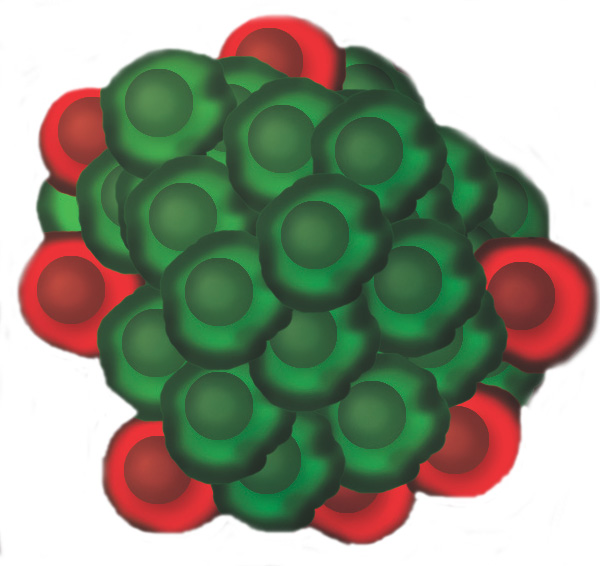New views of inflammation, cancer
The enzyme COX-2 – normally expressed at low levels – increases at sites of inflammation and in pre-malignant and malignant tumors, making it an attractive target for molecular imaging to diagnose and treat cancer.
Jashim Uddin, Ph.D., Lawrence Marnett, Ph.D., and colleagues are developing novel imaging agents that selectively bind to COX-2. In work featured on the cover of the October issue of Cancer Prevention Research, they describe a series of novel fluorine-containing compounds derived from indomethacin or celecoxib that selectively inhibit COX-2. Incorporation of radioactive fluorine (18-F) into one of these compounds provided sufficient signal for in vivo positron emission tomography (PET) imaging.
The 18-F compound was detected at sites of inflammation in animal models, but not in mice missing COX-2. In mice bearing both COX-2-positive and COX-2-negative human tumors, the 18-F compound accumulated only in the COX-2-positive tumor.
The findings suggest that this first COX-2-targeted PET imaging agent will be useful for early detection of cancer and for evaluation of the COX-2 status of pre-malignant and malignant tumors.
— Leigh MacMillan
Information flow reduced in psychosis
Post-mortem studies have reported reduced numbers of interneurons – nerve cells that synchronize and monitor information flow – in brain cortical regions of individuals with bipolar disorder or schizophrenia.

iStockphoto.com
Christine Konradi, Ph.D., and colleagues now extend these findings into new brain regions: the entorhinal cortex (EC) and adjacent subicular regions that together serve as a hub for integrating signals moving between the cortex and the hippocampus. They examined the density of three different interneuron populations in post-mortem brain tissue from patients with bipolar disorder (with psychosis) or schizophrenia, or normal controls. They found a reduction in parvalbumin- and somatostatin-positive interneurons in the EC in bipolar disorder and schizophrenia, but no change in the subiculum. Calbindin-positive interneuron densities were normal in all brain areas examined.
The findings, reported in Acta Neuropathologica, support the notion that psychotic disorders may share a similar pattern of changes in specific interneuron populations, and that these changes likely impact the flow of information between the cortex and the hippocampus.
— Leigh MacMillan
Growth factor boosts beta cells
Transplantation of insulin-producing pancreatic beta cells is showing promise in the treatment of type 1 diabetes. But lab methods for growing transplantation-quality beta cells are not optimal: the yield of beta cells is low, and expansion of the cells has proven difficult.

Maureen Gannon, Ph.D., and colleagues previously showed that a protein secreted by beta cells – connective tissue growth factor (CTGF) – is required for beta cell proliferation during embryonic development. To understand the tissue interactions by which CTGF promotes beta cell growth, the investigators inactivated CTGF in specific cell types in mice. They found that loss of CTGF from either endothelial (blood vessel) cells or beta cells reduced beta cell proliferation. Overexpression of CTGF in beta cells in the embryonic period increased islet mass at birth by promoting proliferation of immature beta cells.
The results, reported in the Sept. 13 Proceedings of the National Academy of Sciences, suggest that inclusion of CTGF may improve methods for growing transplantation-quality beta cells.
— Melissa Marino
Stopping colitis, STAT
Although the inflammatory bowel diseases – ulcerative colitis and Crohn’s disease – have distinct patterns of injury and inflammation, the existing therapies are quite similar and no therapies specifically target the “Th2 immune response” activated in ulcerative colitis.
The signaling molecule IL-13 (a key Th2 cytokine) has been implicated in the pathogenesis of the disease, but no group has demonstrated evidence of increased IL-13 signaling in colon tissues of patients with the disease. Michael Rosen, M.D., MSCI, and colleagues now show that STAT6, the key transcription factor activated by IL-13, is activated in colon tissue from pediatric patients recently diagnosed with ulcerative colitis. In cell experiments, they found that STAT6 is involved in IL-13-induced epithelial cell death and barrier disruption, and that blocking STAT6 with the FDA-approved histone deacetylase inhibitor suberoylanilde hydroxamic acid (SAHA) inhibits these effects.
The results, published in the November issue of Inflammatory Bowel Diseases, suggest that compounds targeting STAT6 may have therapeutic promise in ulcerative colitis.
— Melissa Marino
We welcome suggestions for research to highlight in Aliquots. The items should be primary research articles (no reviews, editorials or commentaries) published within the last two months in a peer-reviewed journal. Please send the article citation (PDF if available) and any other feedback about the column to: aliquots@vanderbilt.edu.
Past Aliquots
June 22, 2012
June 8, 2012
May 11, 2012
April 27, 2012
April 13, 2012
March 30, 2012
March 16, 2012













